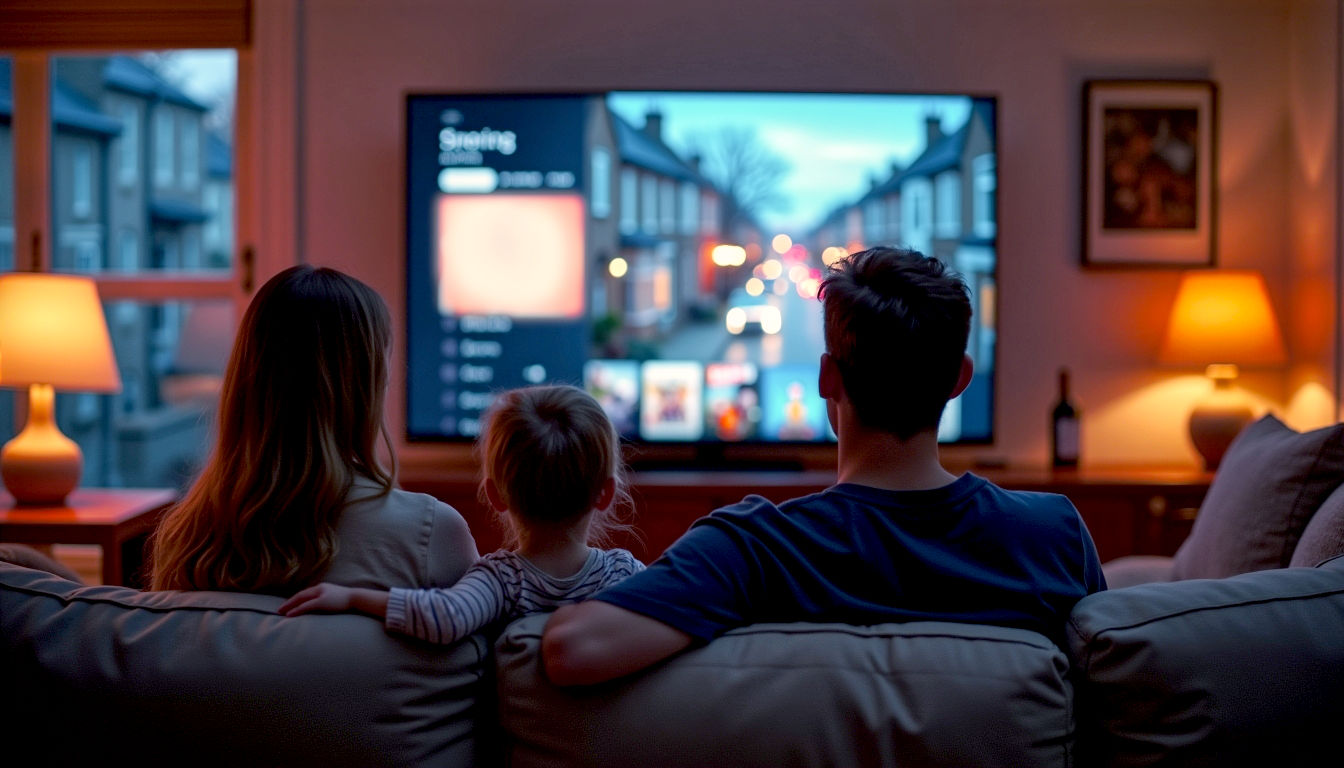From iPlayer to Netflix: The Guide to OTT Platforms and How They Conquered British Telly
A comprehensive breakdown of OTT streaming services in the UK. Learn how platforms like Netflix and BBC iPlayer have revolutionised British television.

This post may contain affiliate links. If you make a purchase through these links, we may earn a commission at no additional cost to you.
Ever found yourself glued to your sofa, phone in hand, binge-watching an entire season of The Crown or cheering on your favourite team on a live sports app? If so, you’re already part of a massive revolution that has completely changed how we watch television. It’s all thanks to something called OTT, or ‘Over-the-Top’ platforms.
You might not know the name, but you definitely know the players: Netflix, Disney+, Amazon Prime Video, BBC iPlayer, and NOW (formerly NOW TV). These services have sneaked into our living rooms and become as normal as having a kettle in the kitchen. They deliver films, box sets, and live events directly over your internet connection, going ‘over the top’ of traditional TV providers like Sky, Virgin Media, or Freeview.
Think about it. Just a decade or two ago, watching TV was a military operation. You had to be on the sofa at a specific time, armed with a TV guide, ready for your favourite show. If you missed it, that was it. Tough luck. Maybe you could catch a repeat later in the week if you were lucky. Now, you’re the boss. You decide what to watch, when to watch it, and where you watch it—whether it’s on your big-screen telly, a tablet on the train, or your phone while hiding from the kids.
This isn’t just a small change; it’s a cultural earthquake. It’s transformed blockbuster movie releases, saved long-lost TV shows from cancellation, and even changed the way we talk to each other. Adverts for the latest must-see series are plastered on buses, and “What are you watching at the moment?” has become the go-to question at the pub.
But how did this happen? How did we go from four channels and a TV aerial to a world of endless choice? This guide will break it all down. We’ll look at where OTT came from, how it actually works (without the boring jargon), and how it’s shaping everything from British filmmaking to our monthly bills. So, grab a cuppa, get comfy, and let’s dive into the world of over-the-top television.
What Exactly Is an OTT Platform? Let’s Break It Down
At its heart, the idea of an OTT platform is pretty simple. It’s any service that streams video content—like TV shows, films, or live sports—directly to you through the internet. The name “over-the-top” comes from the fact that it bypasses the traditional gatekeepers of media.
The Old Way: Traditional TV Broadcasting
For decades, if you wanted to watch television, you had a few options, all controlled by big companies.
- Terrestrial TV: This is what we now call Freeview. A huge transmitter sends signals through the air, and an aerial on your roof picks them up. The BBC, ITV, Channel 4, and Channel 5 have always used this method. You were limited to what they decided to broadcast and when.
- Satellite TV: Companies like Sky put a dish on your house. This dish catches signals beamed down from a satellite orbiting the Earth. It gave you more channels, but you were still tied to Sky’s schedule and their expensive packages.
- Cable TV: Companies like Virgin Media laid physical cables under the ground to pipe television directly into your home. Like satellite, it offered more choice but came with a hefty contract and a set-top box.
In all these cases, one company controlled everything: the content (the shows), the schedule (when you could watch), and the delivery (the cables or satellite signals). You paid them a single, often large, bill for the privilege.
The New Way: Going ‘Over the Top’
OTT completely rips up that rulebook. Instead of using special cables or satellite dishes, it uses the internet connection you already have. Your broadband provider—whether it’s BT, Sky, Virgin, or someone else—just provides the runway. The OTT service is the plane that takes off and lands on it.
Think of it like this: your internet connection is the Royal Mail. You pay them to deliver post to your house. But Royal Mail doesn’t control what you receive. You could get a letter from your nan, a parcel from Amazon, or a magazine subscription.
In this analogy:
- Royal Mail is your Internet Service Provider (ISP) like BT or Virgin.
- The letter from your nan is an email.
- The parcel from Amazon is your Netflix stream.
- The magazine subscription is your Spotify account.
Your internet provider’s only job is to deliver the data. They don’t own Netflix or BBC iPlayer. Those services run independently, right ‘over the top’ of the internet infrastructure. That’s why you can have BT broadband but still watch Sky’s content on NOW, or be a Virgin Media customer and binge a Netflix original series. You are no longer tied to one company for both your internet and your entertainment. This separation is the magic of OTT.
The Different Flavours of OTT: It’s Not Just Netflix
When we think of OTT, Netflix is usually the first name that springs to mind. But the OTT world is much bigger and comes in a few different models, which dictate how you pay for them (or don’t).
1. Subscription Video on Demand (SVOD)
This is the one we’re all familiar with. You pay a flat fee every month, and in return, you get access to a huge library of content to watch as much as you like. It’s an all-you-can-eat buffet of film and TV.
- Examples: Netflix, Amazon Prime Video, Disney+, Apple TV+.
- Why it works: It’s simple and predictable. You know exactly what you’re paying each month, and you get thousands of hours of entertainment. These services hook you with their exclusive ‘Originals’—shows you can’t watch anywhere else, like Stranger Things on Netflix or The Mandalorian on Disney+.
2. Advertising-Based Video on Demand (AVOD)
These services are free to watch, but you have to sit through adverts, just like old-school terrestrial TV. The companies make their money by selling advertising slots to other businesses.
- Examples: ITVX, Channel 4 (formerly All 4), Pluto TV, and the free tier of services like My5. YouTube is the biggest AVOD platform on the planet.
- Why it works: It’s free! This model is perfect for broadcasters like ITV and Channel 4, as it lets them put their shows online for catch-up without charging viewers. It’s a great way to watch content without adding another subscription to your monthly outgoings.
3. Transactional Video on Demand (TVOD)
With this model, you pay for each piece of content individually. It’s like the modern version of the old video rental shop, but without the late fees. You can either ‘rent’ a film for a short period (usually 48 hours) or ‘buy’ it to keep in your digital library forever.
- Examples: Apple iTunes, Google Play Store, Sky Store, Amazon Prime Video Store (yep, Amazon uses a mix of SVOD and TVOD).
- Why it works: It gives you access to the very latest blockbuster films much sooner than they appear on subscription services. If you only watch a couple of new films a month, it can work out cheaper than paying for multiple subscriptions.
Many platforms are now mixing these models. For example, Amazon Prime Video is mainly a subscription (SVOD), but it also has a store where you can rent or buy newer titles (TVOD). And recently, Netflix and Disney+ have introduced cheaper, ad-supported subscription tiers, mixing SVOD and AVOD. They get your monthly fee and show you ads. Clever, eh?
The Journey of OTT: From Niche Idea to Dominating Our Screens
The rise of OTT wasn’t an overnight success. It was a slow-burn revolution built on decades of technological progress, clever ideas, and a growing frustration with the limits of traditional television. To really understand its impact, we need to go back in time.
The Seeds of Streaming: The Dial-Up Days
The dream of ‘video on demand’ is almost as old as the internet itself. In the 1990s, when most of us were dealing with the screeching sound of a dial-up modem, the idea of streaming a full-length film was pure science fiction. The internet was just too slow. A single song could take ten minutes to download; a movie would have taken days.
But the ambition was there. Early pioneers imagined a future where you could click a button and watch anything you wanted. However, the technology just wasn’t ready. It was like trying to drive a Ferrari on a bumpy country lane—the car might be powerful, but the road couldn’t handle it.
The Broadband Boom: The Game Changer
The real turning point came in the early 2000s with the rollout of broadband internet. Suddenly, our digital country lanes were being upgraded to motorways. With faster, always-on internet connections, downloading large files became practical. This is when music services like iTunes took off, and a new video platform called YouTube launched in 2005.
YouTube was a revelation. For the first time, anyone could upload and watch videos instantly, for free. It was mostly cat videos and funny clips back then, but it proved that streaming video over the internet worked on a massive scale. It planted the seed in people’s minds: if we can stream short clips, why not full TV shows and films?
The UK’s Own Pioneer: BBC iPlayer
While America was experimenting with YouTube, the UK had its own hero waiting in the wings: the BBC. As a public service broadcaster funded by the license fee, the BBC has a mission to serve everyone. It saw the potential of the internet early on.
After a few false starts, BBC iPlayer launched properly in 2007. It was a game-changer for British audiences. For the first time, you could catch up on any BBC show you’d missed for free (as long as you had a TV Licence). Missed EastEnders? No problem, it’s on iPlayer. Want to rewatch that amazing David Attenborough documentary? It’s there.
iPlayer was revolutionary because it introduced the UK to the concept of on-demand viewing in a big, mainstream way. It wasn’t some niche tech for geeks; it was for everyone. It normalised the idea of watching TV on your computer and set the stage for what was to come.
The Arrival of the American Giants: Netflix and LoveFilm
At the same time, a little American company called Netflix was quietly changing its business. It started out in 1997 as a DVD-by-post rental service—a direct competitor to Blockbuster. You’d choose films online, and they’d post the DVDs to you.
But its visionary CEO, Reed Hastings, knew that postage was the past and the internet was the future. In 2007, the same year iPlayer launched, Netflix introduced its streaming service in the US. In the UK, a similar DVD rental company called LoveFilm (which was later bought by Amazon) was our main alternative.
The big moment for the UK came in 2012 when Netflix officially launched here. It arrived with a huge library of American shows and films for a low monthly price. It was an instant hit. For the first time, Brits had access to a massive on-demand catalogue that wasn’t just catch-up TV. It was a treasure trove of entertainment.
Amazon followed soon after, rebranding LoveFilm as Amazon Prime Instant Video in 2014. The streaming wars in the UK had officially begun.
The Age of Originals: How Streaming Services Became Hollywood Studios
At first, Netflix and Amazon were just digital libraries. They bought the rights to show films and TV series made by other companies. But they quickly realised that to keep people subscribed, they needed content that you couldn’t get anywhere else.
This led to the era of the ‘Original’. In 2013, Netflix released House of Cards, its first-ever original series. It was a massive gamble—a £100 million political thriller with a Hollywood director and A-list actors. It was a spectacular success and proved that an internet company could make TV shows just as good as, if not better than, the traditional studios.
This changed everything. Netflix, Amazon, and later Apple and Disney, began pouring billions of pounds into making their own exclusive content. This is why we got global hits like The Crown (a British-made Netflix show about our own Royal Family), Stranger Things, and The Boys. These services were no longer just showing content; they were creating it. They had become the new Hollywood.
How Does OTT Technology Actually Work? A Peek Under the Bonnet
So we know what OTT is, but how does a massive 4K film travel from a server in America to your telly in Manchester in a split second? It seems like magic, but it’s actually a very clever bit of technology. Let’s lift the bonnet and have a look, without getting too technical.
Step 1: Compressing the File (Making It Smaller)
A full-length, high-quality film is made up of a staggering amount of data. If you tried to send the raw, uncompressed file over the internet, it would take forever to download, even with superfast broadband. It would be like trying to fit a grand piano through a letterbox.
So, the first step is compression. The video file is squashed down using clever algorithms called codecs. These codecs are like expert packers who know exactly how to remove unnecessary data without ruining the picture quality. They look for bits of the image that don’t change from one frame to the next—like a blue sky or a wall—and just store that information once, instead of over and over again. This makes the file much, much smaller and easier to send.
Step 2: Chopping It Up (Creating Chunks)
Once the file is compressed, it’s not sent to you as one big lump. Instead, it’s chopped up into thousands of tiny little pieces, or chunks, each just a few seconds long.
Imagine you’ve ordered a massive LEGO set online. The company doesn’t send you the fully built model. Instead, they send you a box full of small bricks and a set of instructions. Chopping the video into chunks works in a similar way. It’s much easier and more reliable to send thousands of small packets of data than one gigantic one. If one packet gets lost along the way, your device can just ask for it to be sent again, without interrupting your viewing.
Step 3: Adaptive Bitrate Streaming (The Secret Sauce)
This is the cleverest part of the whole process and the reason your stream doesn’t usually buffer every five seconds. It’s called Adaptive Bitrate Streaming (ABS).
Before the video is chopped up, the OTT platform doesn’t just make one version of it. It makes several versions, all at different quality levels (or bitrates). There will be a super-sharp 4K version, a good-quality HD 1080p version, a standard-definition 720p version, and probably a low-quality version for mobile phones.
Each of these versions is then chopped into chunks. So, for every few seconds of the film, there’s a 4K chunk, an HD chunk, a standard-def chunk, and so on.
When you press play, your device (your TV, laptop, or phone) talks to the OTT server. It says, “Hello! I’m here in London, and my internet speed is currently 50 Mbps.” The server then starts sending the high-quality HD chunks.
But what if someone else in your house starts downloading a huge file, and your internet connection suddenly slows down? Your device immediately detects this. It sends another message to the server: “Whoops, my speed has dropped to 10 Mbps! Things are getting a bit sticky.”
The server instantly switches to sending the lower-quality, standard-definition chunks. You might notice the picture quality dip for a second, but crucially, the film keeps playing without buffering. Once your internet speed picks back up, your device tells the server, and it switches back to sending the HD chunks.
This constant, automatic adjustment is happening all the time in the background. It’s what makes streaming feel so smooth and seamless, whether you’re on superfast fibre broadband at home or a patchy 4G connection on the bus.
Step 4: Content Delivery Networks (Getting It Closer to You)
Even with all this clever tech, sending video from a single server in, say, California, to millions of people across the UK at the same time would be impossible. The distance is too great, and the server would be overwhelmed.
To solve this, OTT platforms use something called a Content Delivery Network (CDN). A CDN is a huge, worldwide network of servers. The OTT company copies its entire library of content onto these servers, which are strategically placed all over the globe.
So, when you decide to watch Bridgerton, you’re not actually streaming it from Netflix’s main headquarters. Instead, you’re streaming it from a CDN server that might be just a few miles down the road from you, in a data centre in London, Manchester, or Glasgow.
This dramatically reduces the distance the data has to travel, which means faster speeds, less delay (latency), and a much more reliable stream. It’s the digital equivalent of having an Amazon warehouse in your local town instead of having to order everything from China.
So, when you put it all together:
- The video is compressed to a manageable size.
- Multiple quality versions are made and chopped into chunks.
- Adaptive Bitrate Streaming automatically picks the best quality chunk for your current internet speed.
- A CDN delivers those chunks to you from a local server.
It’s a beautifully complex system that works together to create a simple, magical experience: pressing play and having your show start instantly.
The Impact of OTT on British Culture and Society
The shift to OTT streaming has done more than just change how we watch TV; it’s fundamentally reshaped British culture, our creative industries, and even our social habits. Some of the changes have been fantastic, while others have created new challenges.
The Death of the TV Schedule and ‘Water Cooler’ Moments
For generations, the TV schedule dictated the rhythm of daily life in Britain. Families would gather to watch Coronation Street. The next day at work or school, everyone would be talking about that dramatic cliffhanger or hilarious sitcom moment. These were our national ‘water cooler moments’—shared experiences that brought millions of us together.
OTT has largely killed this. With everyone watching different things at different times, these shared cultural touchstones are becoming rarer. The finale of a show like Line of Duty on the BBC might still get the nation talking, but for the most part, we’re all in our own little entertainment bubbles. You might be deep into a Korean drama on Netflix, while your colleague is watching a documentary on Amazon Prime, and your friend is catching up on a reality show on ITVX.
The upside is freedom and choice. The downside is a sense of cultural fragmentation, where we have fewer shared TV moments to bind us together.
A New Golden Age for British Television Production?
One of the most significant impacts of the streaming boom has been on the UK’s film and TV production industry. The global giants like Netflix, Amazon, and Disney have fallen in love with Britain. Why? Because we have world-class studios (like Pinewood and Shepperton), incredibly talented actors and crews, beautiful filming locations, and attractive tax breaks.
As a result, they have poured billions of pounds into making content here. Netflix struck a landmark deal to create a permanent production hub at Shepperton Studios, and Disney has a similar long-term arrangement at Pinewood.
This has led to a production boom. Huge, international hits that feel quintessentially British are being funded by American companies. Think of:
- The Crown (Netflix): A lavish, award-winning drama about our own monarchy, filmed across the UK.
- Sex Education (Netflix): A quirky comedy-drama set in a fictional Welsh school, showcasing stunning Welsh landscapes.
- Bridgerton (Netflix): A Regency-era romance filmed in Bath, London, and stately homes across the country, which has become a global phenomenon.
This investment has created thousands of jobs, from actors and directors to carpenters and costume designers. It has supercharged our creative economy and turned the UK into a global hub for high-end TV production. It’s a new golden age, funded by the deep pockets of the streaming giants.
The Challenge to Public Service Broadcasting
However, this boom comes with a threat. Our traditional Public Service Broadcasters (PSBs)—the BBC, ITV, Channel 4, and Channel 5—are facing their biggest challenge ever.
These broadcasters have a legal duty to produce content specifically for British audiences. They have to make news, children’s shows, religious programming, and content that reflects all parts of the UK. They are the bedrock of our television culture.
But they are now competing with global behemoths that have budgets bigger than the GDP of some small countries. How can the BBC, funded by a license fee that is frozen or falling in real terms, compete with Netflix, which spends over £13 billion a year on content?
Younger audiences, in particular, are turning away from traditional channels and spending more of their time on YouTube and subscription services. They don’t have the same loyalty to the BBC or ITV that their parents did. This poses an existential threat to the PSB model. If people no longer feel they get value from the license fee, what is the future of the BBC?
Broadcasters are fighting back. BBC iPlayer is a world-class service, ITV has launched its revamped streamer ITVX, and Channel 4 continues to produce edgy, distinctive British content. But they are in a fight for their lives against rivals with almost limitless cash.
The Rise of the ‘Subscription Stack’ and Bill Shock
For viewers, the explosion of choice is exciting, but it also comes at a cost. In the old days, you might have had one big Sky bill. Now, your entertainment costs are spread across multiple subscriptions.
Many households now have what’s called a ‘subscription stack’:
- Netflix for that must-see drama.
- Disney+ for the kids (and the Marvel and Star Wars fans).
- Amazon Prime for the football and the free delivery.
- NOW to get access to Sky Atlantic’s big shows without a contract.
- Spotify for music.
- Maybe even a niche service like MUBI for indie films or Crunchyroll for anime.
Individually, each subscription might seem cheap—just £7.99 or £10.99 a month. But add them all together, and many families are spending £40, £50, or even more every month on streaming services, on top of their broadband bill and TV Licence. This can lead to ‘subscription fatigue’ and a nasty surprise when you check your bank statement. It’s a new kind of bill shock for the digital age.
The Future of OTT: What’s Next for Our Telly?
The world of OTT never stands still. The technology is constantly evolving, and the battle for our eyeballs is only getting more intense. So, what does the future hold? Here are a few trends to watch out for.
1. The Great Un-Bundling… and Re-Bundling
For years, the story of OTT was about ‘cord-cutting’—ditching your expensive Sky or Virgin package in favour of a collection of cheaper streaming apps. This was the great un-bundling.
But now, with so many services to choose from, things are getting complicated and expensive. In response, we’re starting to see the beginnings of re-bundling. Companies are looking for ways to package multiple services together for a single, discounted price.
For example, your mobile phone provider might offer a deal that includes a subscription to Netflix or Disney+. TV manufacturers might do deals to promote certain apps. In the future, you might see companies like Sky or Virgin transform from being content gatekeepers into being ‘super-aggregators’—platforms that bring all your different streaming subscriptions together in one place, with one bill and a single, easy-to-use interface. It’s the old model, reinvented for the streaming age.
2. Live Events Will Be the Next Battleground
While on-demand shows and films have been the driving force of OTT so far, the next major battleground is live events, especially sport.
Sport is one of the last things that can still guarantee a huge, live, engaged audience. Traditionally, it’s been locked down by Sky Sports and TNT Sports (formerly BT Sport). But the streaming giants are starting to muscle in.
Amazon Prime Video already has the rights to show Premier League matches and major tennis tournaments in the UK. Apple TV+ is investing heavily in live football in the US. It’s only a matter of time before Netflix or Disney makes a serious play for top-tier sports rights in the UK.
This could fragment sports viewing even further. In the future, to follow your favourite football team, you might need a subscription to Sky, TNT, and Amazon. For fans, this could be a confusing and expensive nightmare.
3. More Adverts (But Smarter Ones)
The days of streaming being a blissfully ad-free world are coming to an end. As growth slows down, services like Netflix and Disney+ have already launched cheaper, ad-supported tiers to attract more customers. This trend is only going to continue.
However, these won’t be the same dumb ads you see on traditional TV, which are the same for everyone. OTT platforms know a huge amount about you: what you watch, when you watch, and maybe even your age and location. They can use this data to deliver highly targeted, personalised adverts.
So, if you’ve been watching lots of gardening shows, you might see an ad for B&Q. If you’ve been watching shows with your kids, you might see an ad for a family holiday. It’s a bit creepy, but for advertisers, it’s incredibly powerful.
4. Interactive and Immersive Experiences
Finally, the technology itself will continue to push boundaries. We’ve already seen early experiments with interactive storytelling, like Netflix’s Black Mirror: Bandersnatch, where you could make choices that affected the plot. Expect to see more of this.
Beyond that, the lines between gaming and television will continue to blur. Imagine watching a show and being able to explore the set in virtual reality (VR) or play a game as one of the characters. With the rise of the ‘metaverse’ and faster, more powerful devices, the passive experience of watching TV could become something much more active and immersive.
The OTT revolution is far from over. It has already torn down the old certainties of the television world and put viewers in charge in a way that was once unimaginable. It has fuelled a creative boom in the UK, but also posed serious questions about the future of our national broadcasters and the risk of cultural fragmentation.
One thing is certain: the way we watch, create, and think about television has been changed forever. The remote control is now more powerful than it has ever been. The only question is, with a universe of content at your fingertips, what will you choose to watch next?
Conclusion: The Revolution Will Be Televised, On-Demand
We’ve journeyed from the rigid schedules of four-channel telly to a boundless, on-demand universe of entertainment. The rise of Over-the-Top platforms is more than a story about technology; it’s a fundamental reshaping of our culture, our creative industries, and our living rooms.
For us, the viewers, the balance of power has decisively shifted. We are no longer just an audience; we are curators, programme directors, and critics of our own personalised channels. This incredible freedom to watch what we want, whenever we want, has given us access to a world of stories we’d never have found otherwise. The trade-off? The slow erosion of those shared, national “water cooler” moments that once united us around a single broadcast.
For Britain’s world-class creative sector, the OTT boom has been a thrilling, yet challenging, whirlwind. It has injected billions into our economy, turning the UK into a global production hub and creating countless jobs. But this golden age comes with a shadow, as our beloved public service broadcasters—the BBC, ITV, and Channel 4—face an uphill battle for relevance against global giants with near-limitless resources.
And this story is far from its final chapter. The future promises even more change: live sports will become the next great streaming battleground, advertising will get smarter (and perhaps a little creepier), and technology will continue to blur the lines between watching and participating.
The television aerial on the roof might be a relic of a bygone era, but the screen it once served has never been more central to our lives. The OTT revolution didn’t just give us more choice; it put the remote control back in our hands and, with it, the keys to a kingdom of content. The only question that remains is, what will you watch tonight?
Further Reading:
For those who wish to delve deeper into the subject, here are some highly respected resources that provide ongoing analysis and data about the UK media landscape:
- Ofcom: The UK’s communications regulator. Their annual reports and research on viewing habits are the definitive source for industry data. https://www.ofcom.org.uk/research-and-data
- Royal Television Society (RTS): The RTS provides a wealth of articles, analysis, and events focused on the British television industry, often covering the impact of streaming platforms. https://rts.org.uk/
- The Guardian – Media Section: For insightful journalism, critical analysis, and up-to-date news on the streaming wars and their effect on British culture. https://www.theguardian.com/media
- Enders Analysis: A leading research firm in the media and technology sectors. While much of their content is subscription-based, their public reports and press mentions offer expert insight. https://www.endersanalysis.com/






